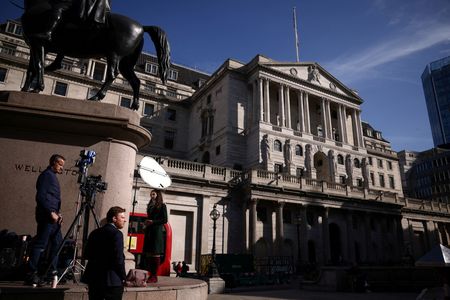By Wayne Cole
(Reuters) – A look at the day ahead in European and global markets from Wayne Cole.
It’s been predictably subdued in Asia as a U.S. holiday provides a convenient excuse for stocks to consolidate recent hefty gains before a bevy of central bank meetings this week. Most indices are down, with the Nikkei off modestly having climbed 22% over a 10-week streak to hit 33-year highs.
S&P 500 futures were also flat having risen for five weeks in a row, while the NASDAQ has notched eight weeks of gains. Those rallies are narrowly based, though, with just nine large-cap stocks making up 30% of the S&P 500. It’s hard to call the index a “diversified” investment any more.
Markets are watching U.S. Secretary of State Antony Blinken’s visit to Beijing, though you know expectations are low when it’s newsworthy that a Chinese diplomat deigned to shake his hand.
Among currencies, the yen downtrend remains alive and well as the euro and dollar both make new highs, albeit by just a few ticks. Further losses look likely unless and until the Bank of Japan takes another step toward tightening, which many Western analysts see as possible in July. Governor Kazuo Ueda, however, seemed to set a high bar for a move last week by saying his outlook for inflation would have to shift “sharply” to justify a move.
The coming week is also jammed with central bank action, led by China on Tuesday where prime loan rates are expected to be cut by 10 basis points. That might be pushing on string given mortgage rates have already fallen markedly and lower rates only eat into the return on household savings. Markets are really hanging on for more fiscal stimulus to revive growth, as it has so often in the past.
Federal Reserve Chair Jerome Powell appears before lawmakers on Wednesday and Thursday and may again try to convince markets that two more quarter-point rate hikes are really, honestly, cross-my-heart likely.
Futures seem unimpressed with just 21 basis points of tightening priced in by September, though one final hike in July is rated as a decent 70% chance.
In contrast, markets are baying for the Bank of England to hike when it meets on Thursday, the only question being by 25 or 50 basis points. Futures lean toward the smaller move to 4.75% but also have rates rising to at least 5.75% given stubborn inflation and surging wages.
Gilt yields have already hit 15-year highs, causing havoc in the UK mortgage market and lifting the government’s already astronomical borrowing costs.
Rate hikes are also expected in Norway and Switzerland this week, perhaps by 50 basis points, though that will likely pale in comparison to Turkey’s central bank as some analysts see rates rising from the current 8% to as much as 25%.
Key developments that could influence markets on Monday:
– ECB board member Isabel Schnabel, ECB Vice President Luis de Guindos and ECB chief economist Philip Lane are all speaking
– U.S. stock and bond markets are closed, while the NAHB housing market index for June is due
(By Wayne Cole; Editing by Sam Holmes)





